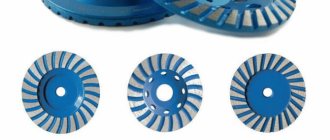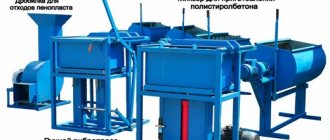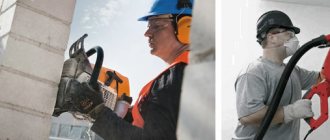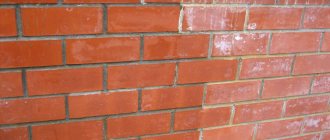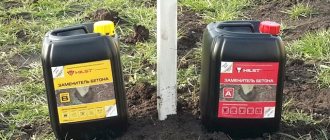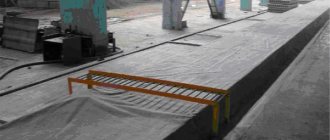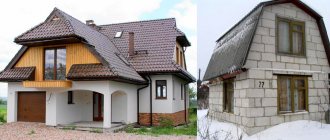Concrete dust, which during the operation of concrete floors appears on the surface of the latter, is a substance harmful to the human body. You can get rid of it in different ways. Many people prefer the simple option – concrete grinding. Let's figure out what this technology is, what tools and devices are used for this, and also outline some of the nuances of the technological process.
Grinding a concrete floor Source polyvtomske.ru
Performance characteristics of sanded floors
Polished concrete has serious characteristics that are not inferior to most high-quality finishing floor coverings. Here are just a few of them:
- This type of flooring will last for decades. And this is due not only to the high strength of concrete, but also to such an indicator as resistance to oversaturation with moisture. Without grinding or finishing, concrete floors quickly absorb moisture, losing their performance and technical characteristics.
- If you grind the concrete base and polish it, it can be compared with self-leveling floors.
- The cost of construction operations for grinding is low.
- The sanded surface is an ideal basis for finishing.
- Such floors do not emit dust, as mentioned above.
- Sanding allows you to slightly level the floors.
- This type of flooring does not require repair. But even if for some reason defects suddenly appear on a section of the floor, repairing them is easy and inexpensive.
Attention ! Keep in mind that sanding a concrete floor will not solve the problem of uneven floors. This operation has completely different tasks. Therefore, even at the stage of forming the base, fill the screed according to the level.
How to use a self-leveling polymer floor Source polimersts.ru
Milling machine processing technology
Milling of concrete is carried out by special milling machines with cutting diamond segments. The surface is processed with a drum using a star-type tool. The operating principle of the machine is simple - the drum rotates, a centrifugal force appears along its transverse axis, and under the pressure of torque, a cutter is thrown out, which hits the surface of the concrete and acts on it in a certain way (cuts, stabs).
The higher the impact force, the thicker the layer removed during the milling process.
Modern, highly efficient milling machines allow you to process large areas and work with specific and complex surfaces, which is made possible thanks to the variety of cutters. For processing concrete, ordinary cutting diamond discs and cutters of a special design are used, made with hammered diamonds at the ends or soldered segments along a helical line.
Types of grinding
It should be noted right away that the technology for sanding floors is the same for everyone, where the same tools and equipment are used. The approach to implementing the required operation simply differs. Therefore, we will consider each type separately.
Dry technology
This is the most common type of grinding and is used more often than others. In essence, this is ordinary grinding without additional devices and materials. Its disadvantage is the large volume of dust that rises and fills the entire space of the object. Therefore, the work contractor must provide his employees with protective equipment. Namely, respirators, goggles, mittens, overalls and shoes.
On the other hand, cement dust settles quite quickly. And this makes it possible to immediately evaluate the results of work, and accordingly quickly respond if there are defects on the floor.
The thickness of the removed layer with this method is no more than 2 mm.
Dry concrete grinding technology Source mosstroyprokat.ru
Wet technology
From the name itself it becomes clear that water is used during this operation. Therefore, some masters call this method dustless.
Let us immediately make a reservation that the complexity and severity of the procedure is higher, and it takes much more time. At the same time, during the grinding process, a huge volume of dirty splashes is formed, which also complicates the work.
The maximum layer to be removed is 5 mm. This option is most often used if the concrete floor is covered with stone chips or mosaics.
Attention! A mandatory procedure is the quick removal of concrete sludge, which is formed instead of dust. If you do not remove it in time, after drying it can only be chipped off, which will lead to damage to the floor as a whole.
Sanding a water-soaked floor Source remoo.ru
Polishing
This type of construction operation cannot be called grinding, as such. But the technology itself is the same. It’s just that more “thin” devices are used to carry it out, mounted on a grinding machine.
After polishing, the concrete floor becomes glossy. Let's face it, it's not a cheap pleasure, but the end result of the coating is stunning. In terms of its aesthetic characteristics, a polished concrete base will not be inferior to self-leveling floors. Therefore, concrete polishing is a very popular service today.
Polishing a concrete base Source tehno-beton.ru
See also: Catalog of companies that specialize in the reconstruction and rebuilding of houses and related work.
Stages of work
Regardless of the chosen grinding technology, it is first necessary to prepare the surface. For this:
- remove the old coating (if any);
- remove protruding reinforcement;
- drill holes if they are provided for in the project (drilling after sanding will spoil the appearance of the finished floor);
- fill up potholes and cut off gouges identified when checking the evenness of the surface using a three-dimensional ruler;
- The rigidity of a fresh screed is checked - grinding work can only be done after it has gained strength, otherwise the attachment on the grinder will tear out pieces of concrete, clinging to the filler.
Removing defects
Cracks in concrete are opened, cleaned of dust, and treated with a primer. Then they are filled with cement-based repair mortar and smoothed with a rule. Using the same principle, hollows and shells are removed. Irregularities above 5 mm are cut off with a diamond disc and dust is removed.
Grinding process
For diamond grinding of concrete, abrasive wheels with grapples of different fractions are used sequentially: 25-30 units at the initial stage and 40 for final grinding. Polishing to give the surface a gloss is carried out using discs with abrasive chips of 1500-3000 units.
Stages of work:
- The prepared surface is impregnated with a special strengthening solution.
- The floor is sanded in several passes to reduce the size of abrasive particles until smooth using a dry or wet method. In the second case, it is watered generously with water before processing.
Before using a household or industrial grinder (they can be rented), you should study the instructions in detail. In hard-to-reach places, the floor is processed using an angle grinder.
If the entire surface is sanded with a grinder, it is necessary to take breaks every 10-15 minutes to avoid damage to the tool from overheating.
At the final stage, the sanded floor is cleaned of dirt and dried. Next, it is coated with concrete paint or polyurethane varnish in 2-3 layers with intermediate drying.
Equipment and accessories for grinding
It must be said that the proposed grinding equipment is divided into classes, which are based on the area of the surface being processed. The higher this indicator, the more professional the equipment should be.
Grinding machines are based on the same principle – rotation of the attachments around their own axis and around the axis of the equipment’s working shaft. Many models today are equipped with additional options. For example, collecting dust and supplying water to the grinding area.
If the area prepared for grinding is small, for example, your own garage for one car, then you can get by with an ordinary grinder.
Mosaic grinding machine for concrete Source ufaprom.ru
Now, regarding the devices. Here everything is as always - the better the quality of the nozzle, the higher the quality of the final result. But it is very important to choose the right tool in terms of the type of concrete floor being processed. To make it clear, let's talk about grinding discs.
They are presented on the market in several modifications. One of the varieties is disk nozzles , which are divided into two types:
- The so-called turtles . These are flexible discs on which diamond chips mixed with a polymer composition are applied. The turtles are attached with Velcro, which allows them to be quickly removed and installed. Typically, this working tool is used for fine grinding of concrete floors.
- Faceplates . This is a cast disc with diamond coating. Used for roughing. Manufacturers offer several models that differ in the size of the diamond chips, which allows you to choose them depending on the structure of the floor base. That is, it is concrete or stone.
Turtles - nozzles for concrete Source samodelkinspb.rf
Safety regulations
A mandatory condition for maintaining safety when performing milling work is to clear the processed area from debris, various mechanisms and building materials. When milling concrete surfaces, it is necessary to exclude the possibility of various metal objects getting into the cutting tool area, which can cause damage to quite expensive equipment.
Machines with an electric drive are connected to the electrical network only through a protective-disconnecting device using a plug connection equipped with a protective-grounding contact . Before connecting the machine, you must check the functionality of this device. During work, do not allow moisture and dust to enter the protective circuit-breaker device and the plug connection. If the disconnecting device is triggered, it can only be switched on again after the damage to the machine has been repaired.
Conducting wires must be protected from sharp bends and friction against sharp objects or corners , and must not be twisted or come into contact with hot surfaces. When moving the machine along the surface being treated, you must ensure that various foreign objects do not fall under its working parts and wheels.
Before working with an electric milling machine, it is necessary to check the condition of the insulation of the power cable, dielectric boots and gloves
It is not allowed to work with milling machines if the switches are not working properly, lubricant is leaking from the drive, or if there is increased noise, vibration, knocking or smell characteristic of burning insulating materials. It is not allowed to work with the machine if cracks appear in the elements of the body or handle or if the fastening of the working parts is loose .
It is prohibited to work with equipment that does not have a guard for the traverse of the blades or belt drive, or to use homemade devices to fix the clutch in the engaged position. The operator working with the milling machine is prohibited from transferring it (even for a short time) to another person, as well as from disassembling it and independently carrying out any repairs to its electrical or mechanical parts.
Before starting work you need to check:
- tightening of threaded connections;
- serviceability of the grounding device to which the machine will be connected;
- no short circuits to the body;
- integrity of the grounding circuit and grounding wire;
- correct connection of the neutral wire.
Rules and nuances of grinding
Having figured out how to grind concrete, we move on to the technology for carrying out this process. Like any construction process, it is divided into two main stages: preparatory and grinding itself.
Concrete floor preparation
It is necessary to immediately make a reservation that if it is necessary to make any changes in the body of the floor base, then this must be done right now. For example, the formation of grooves, holes and other things. Then the concrete base is inspected for quality:
- pieces of reinforcement or other metal profile protruding from the floor are cut off flush with the plane;
- cracks, chips and other defects are repaired and aligned with the main plane;
- ideally, tap the entire surface and identify “weak” spots that are best opened and filled with concrete;
- if the poured screed has large differences in plane, then it is better not to start sanding; the floors must be leveled;
- Grinding concrete with a grinding machine can begin a few days after pouring the solution; old structures are sanded after preparation.
Preparing a concrete floor for grinding Source concretepol.com
Features of processing concrete surfaces
When treating the surface of concrete, you must adhere to certain rules. First and foremost, the machine must meet the assigned tasks and be used in accordance with safety requirements.
Rules for milling concrete:
- It is allowed to work only on a completely dry surface - if sludge and dust mix with moisture, the cutting tool will soon clog
- For high-quality dust protection, use a construction vacuum cleaner.
- Before starting work, thoroughly clean the surface of debris and remnants of building materials.
- When performing the first pass, move the milling machine parallel to the wall so that the trajectory is smooth and further passes are accurate, allowing you to properly level and remove the cement coating
- Milling is prohibited from performing where there is a risk of touching reinforcement or communications.
Thanks to the use of milling machines, it is possible to ensure high quality processing and achieve the desired properties of the concrete base. Among the disadvantages of this processing method, it is worth noting the high noise level and a considerable amount of dust.
Marking the area, removing turf and opening a pit
To mark the future foundation you will need pegs, a rope that will be pulled over them, and paint (it can be replaced with chalk). After completing the application of the contours, you should begin to remove the turf layer and open a pit (or trench). It is most convenient to remove the turf with a bayonet-type shovel; it cuts the roots well. To remove large layers, you should use a pitchfork. To dig trenches, you will need a shovel, and to transport the excavated soil, a wheelbarrow and a bucket (this is necessary for working in cramped conditions). If the site has rocky soil, you will additionally need a pickaxe.
Laying formwork
Placing the concrete mixture into the mold and its subsequent removal are the most important and labor-intensive operations during concrete work. For their successful implementation, special tools and technologies will be needed. To smooth out the mixture placed in the mold, you must use the manual rule. For compaction purposes, vibrating screeds are used, which can be made of steel or aluminum. For ease of transportation, some slats are made telescopic. The choice of tool length and design depends on the expected scope of work.
Electrical appliances
The use of electromechanical devices powered by mains or fuel can significantly reduce work time and costs. Methods of laying concrete involve the use of:
- vibrating slats to smooth the surface of spilled concrete;
- large-sized vibrating platforms for leveling large areas;
- concrete mixer for working with liquid cement mixture. Their use produces a homogeneous solution with good density, without lumps or foreign inclusions;
- automatic smoothing machines for stripping material and polishing its surface. Such devices are connected to the mains and controlled by a special handle;
- heat generators that dry the laid concrete and accelerate its hardening.
